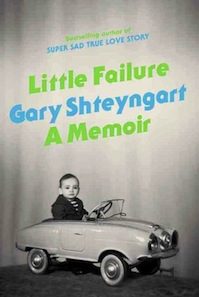
Early in his memoir, Little Failure, Gary Shteyngart lists the graduate school brochures that collected in his parents’ mailbox during his first years after college. The list begins, impressively, with Harvard Law School, and then follows, by his parents’ standards, a steady downward trajectory, through Fordham Law School and the Cornell Department of City and Regional Planning to what Shteyngart calls “the most frightening prospect for any immigrant family, the master of fine arts program in creative writing at the University of Iowa.”
“But what kind of profession is this, writer?” his mother asks. “You want to be this?”
“I want to be this,” Shteyngart writes.
He didn’t get into Iowa––it would be years before he got into any MFA program––but Gary Shteyngart eventually became the author of three critically acclaimed bestsellers, a regular contributor to the New Yorker, GQ, and the New York Times Magazine, the star of book trailers featuring James Franco and Jonathan Franzen, and one of the first culture makers asked to try out Google Glass.
That’s how you know you’ve made it: They ask you to try out Google Glass.
Perhaps the best measure of Shteyngart’s success is that, because he is America’s most ardent and prolific blurber, it is hard to find a contemporary novel that does not have his name on the cover.
How did an asthmatic Russian child grow up to achieve so much? (Did I mention his hilarious Op-Ed for the New York Times on the indignities of airline travel? That he has only 31,000 followers on Twitter but still has one of those blue checkmark thingies?)
Little Failure is a memoir in two interwoven strands. First, it tells the story of how Gary Shteyngart became a writer. It happens like this: Because he suffers from asthma and is physically weak, Shteyngart spends most of his childhood indoors, reading and dreaming. For reasons that are not fully explained, he also spends a large part of his childhood dressed, and posing for professional portraits, as a member of the Russian navy. (Hence the hilarious cover photograph.) Shteyngart doesn’t really explain the role of his sailor outfit in his literary development, but his convalescent boyhood makes him a writer before he’s out of middle school. By the time he enters college, he has written three novels, The Chalenge [sic], its sequel Invasion from Outer Space, and the lost manuscript of Lenin and His Magical Goose. He is already a novelist. The only question is whether he will find a way to make a living as one.
It would be enough if this were Little Failure’s only angle. Gary Shteyngart has a fascinating life story, it’s fun to follow his pinball course from St. Petersburg to Queens to Oberlin and back to Manhattan, and there’s a voyeuristic pleasure in glimpsing the real-life material he crafted into fiction. The story even has a happy ending: Shteyngart is lifted from literary obscurity by the aid of an unlikely benefactor, years of psychotherapy, and a manuscript it takes him six years to complete.
But Little Failure does not simply tell the story of Gary’s Shteyngart’s zig-zag path to literary stardom. It’s also a character study, the character being the real-life Gary Shteyngart. Structured like a Russian nesting doll, the story moves inward as it moves forward, with Shteyngart repeatedly opening himself up for further scrutiny until the core of his identity is revealed.

And so Little Failure opens, not in St. Petersburg in the 1970’s, but in the Financial District in 1996. Shteyngart, a young Oberlin graduate, is on a vodka-fueled four-hour lunch, leafing through a picture book on St. Petersburg architecture at the Strand Book Annex. When he comes across a photo of the “raspberry and white candy box” of the neo-Gothic Chesme Church, a place he last visited when he was five, he suffers a panic attack.
Years later, on his first return to St. Petersburg in twenty-two years, Shteyngart suffers a similar panic attack when he pays a personal visit to the church.
Why does the Chesme Church send him into a panic? What happened there twenty-two years ago?
The answer will tell Gary Shteyngart who he is, and provide Little Failure with its deeper meaning, informed by Shteyngart’s years of Freudian analysis. We see, in hindsight, the childhood influences that shaped his personality, and, years later, his efforts to counteract them. He makes better choices in relationships. He tries not to relay his parents’ anger to his friends. He stops treating himself as the little failure his parents made him think he was.
Shteyngart’s therapy also transforms him into the Six Million Dollar Literary Man. He is better, faster, stronger. More introspective. More disciplined. More sensitive and empathetic. Indeed, Little Failure seems to represent a kind of therapeutic and literary breakthrough for Shteyngart. He appears to have discovered that the subject he’s been chasing in his fiction is his own experience, and to have found a more natural form for its expression.
Little Failure is not only a departure in terms of subject, it is a departure in terms of style. Shteyngart’s narrative voice is still brilliantly inventive, still densely packed with strange and vivid details, and still hilarious, but it is less antic and more personal. As Shteyngart explains in the book’s home stretch:
On so many occasions in my novels, I have approached a certain truth only to turn away from it, only to point my finger and laugh at it and then scurry back to safety. In this book, I promised myself I would not point the finger. My laughter would be intermittent. There would be no safety.
Its prose may still light up the page, and its story may still read, at times, like a comic road novel, but Little Failure is also graced by passages that are quieter and closer to the bone. I don’t know whether it is Shteyngart’s best book, but it is his bravest and his most sincere.
The most compelling aspect of Little Failure may be that it seems, itself, to represent a step in Shteyngart’s personal literary development. By trying to tell a story that does not so often joke about emotional subjects and run away from them, and which brings a greater level of emotional honesty to the page, Shteyngart appears to be trying, before the reader’s eye, to become a stronger and more daring writer.
If, to follow Samuel Beckett’s famous passage from Worstward Ho, every worthwhile attempt is doomed to fail, and the important thing is to keep failing in the hopes of failing better, then Little Failure is, itself, a little failure. By which I mean it is a winning attempt. Its moving portrait of its author––his struggles as a Russian child and a young American, his determination to become a successful writer and a better person––stands as a record and example of its author’s progress. On every level, Little Failure is a great success.




